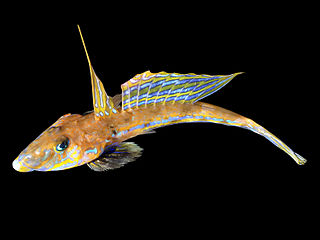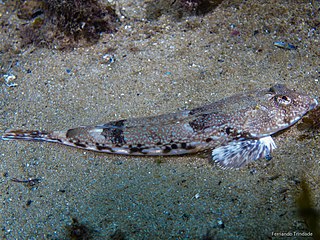
Dragonets are small, percomorph, marine fish of the diverse family Callionymidae found mainly in the tropical waters of the western Indo-Pacific. They are benthic organisms, spending most of their time near the sandy bottoms, at a depth of roughly two hundred meters. There exist 139 species of the fish, in nineteen genera.

Callionymus is a genus of dragonets found mostly in the Indian and Pacific oceans with a few species occurring in the Atlantic Ocean.

The lancer dragonet, Baird's dragonet, coral dragonet or St Helena dragonet, is a species of dragonet native to the warmer waters of the Atlantic Ocean where it occurs at depths of from 1 to 91 metres. In the western Atlantic it occurs from Cape Hatteras southwards along the east coast of North America. including Bermuda and the Bahamas, into the Gulf of Mexico and throughout the Caribbean Sea. It has also been recorded from Ilha da Trindade off Brazil. In the eastern Atlantic it has been recorded from the Cape Verde Islands, Ascension Island, St. Helena, and Sao Tome e Principe in the Gulf of Guinea. This species grows to a length of 11.4 centimetres (4.5 in) TL.
Callionymus bentuviai, Ben-Tuvia's deepwater dragonet, is a species of dragonet endemic to the Red Sea. This species grows to a length of 6.3 centimetres (2.5 in) SL.

The delicate dragonet is a species of dragonet native to the Red Sea through the Indian Ocean to the western Pacific Ocean. It occurs at depths of from 1 to 20 metres. This species grows to a length of 6 centimetres (2.4 in) TL.

The banded dragonet is a species of dragonet native to the Mediterranean Sea from the Gulf of Genoa to the western Aegean Sea. Also known from the southern and eastern Black Sea. It prefers sandy substrates where its diet consists of benthic invertebrates.
The Blotchfin dragonet is a species of dragonet native to the Indian Ocean and the western Pacific Ocean. It also now occurs in the Mediterranean Sea, where it was first recorded in 1953 off Israel, having invaded as a Lessepsian migrant through the Suez Canal. This species occurs at depths of from 16 to 350 metres. This species grows to a length of 20 centimetres (7.9 in) TL.
Callionymus flavus, the yellow ruddertail dragonet, is a species of dragonet endemic to the Red Sea.
Callionymus io, the Andaman Sea spiny dragonet, is a species of dragonet endemic to the Indian Ocean waters off of Myanmar. This species grows to a length of 2.5 centimetres (0.98 in) SL.

The common dragonet is a species of dragonet which is widely distributed in the eastern North Atlantic where it is common near Europe from Norway and Iceland southwards. It is a demersal species that occurs over sand bottoms. It lives to a maximum age of around seven years. It is caught in bycatch by fisheries and is used in the aquarium trade.
Callionymus macclesfieldensis, the Macclesfield dragonet, is a species of dragonet found only on the Macclesfield Bank in the South China Sea where it is found at depths of from 77 to 82 metres. This species grows to a length of 5 centimetres (2.0 in) SL.
The spotted dragonet is a species of dragonet native to the eastern Atlantic Ocean and the Mediterranean Sea where it occurs at depths of from 45 to 650 metres. This species is important to local peoples engaged in subsistence fishing.
Callionymus muscatensis, the Muscat dragonet, is a species of dragonet native to the southern portions of the Red Sea and the Gulf of Oman. This species occurs at depths of from 40 to 70 metres. This species grows to a length of 7.5 centimetres (3.0 in) TL.

The Sailfin dragonet is a species of dragonet common in the Eastern Atlantic, where it occurs on the Portuguese coast to as far north as Lisbon and south to Morocco, and also in the northern Mediterranean including the Adriatic, Aegean and Black seas as well as the coastsLebanon and Israel. It occurs on the southern Mediterranean shore as far east as Tunisia Males of this species grows to a length of 14 centimetres (5.5 in) TL while females reach a length of 10 centimetres (3.9 in) TL. In the areas of the Mediterranean where it occurs it is one of the commonest dragonet species, as it is the only species that has been recorded within many protected areas. It is a benthic species which occurs in shallow waters and prefers sandy bottoms down to 100 metres (330 ft). The males are territorial, aggressively defend their territories from other males and like other dragonets this species undergoes complex breeding behaviour which has 4 phases. This starts with courtship, the male and female then form a pair before ascending to the surface where they release eggs and milt. The spawning season runs from May to August in the Mediterranean and the eggs and larvae are pelagic. This species feeds mainly on small benthic invertebrates such as worms and small crustaceans.

The reticulated dragonet is a species of dragonet native to the northeastern Atlantic Ocean and the Mediterranean Sea where it is found at depths of from 0 to 110 metres. This species grows to a length of 11 centimetres (4.3 in) TL. This species has a flattened head and body, the head has a triangular shape with the eyes placed on the top of the head. It has two dorsal fins with the first one being triangular in shape. It has blue spots along the flanks and four saddle-like markings on their backs which have sharply defined outlines. It is similar to the common dragonet but is distinguished by its smaller size and the sharply defined border around the saddle markings on the back.

Risso's dragonet is a species of dragonet native to the Mediterranean Sea as well as the Black Sea and rarely found off of Portugal in the Atlantic Ocean. This species can be found at depths of from 15 to 150 metres. Males of this species grows to a length of 11 centimetres (4.3 in) TL while females reach a length of 6.5 centimetres (2.6 in).

The arrow dragonet, also known as the arrow-headed darter dragonet, is a species of dragonet widespread in the Indo-West Pacific from Arabian Peninsula to the Philippines. Occurs in the Mekong delta of Viet Nam and probably also in Cambodia. This species grows to a length of 11 centimetres (4.3 in) TL. The arrow dragonet is a demersal species, which occurs on sandy substrates along coastlines, in estuaries, and in the lower courses of rivers where it feeds on worms, zooplankton and phytoplankton.
Cleotrivia colettae is a species of small sea snail, a marine gastropod mollusk in the family Triviidae, the false cowries or trivias.
Purpurcapsula exigua is a species of small sea snail, a marine gastropod mollusk in the family Triviidae, the false cowries or trivias.







